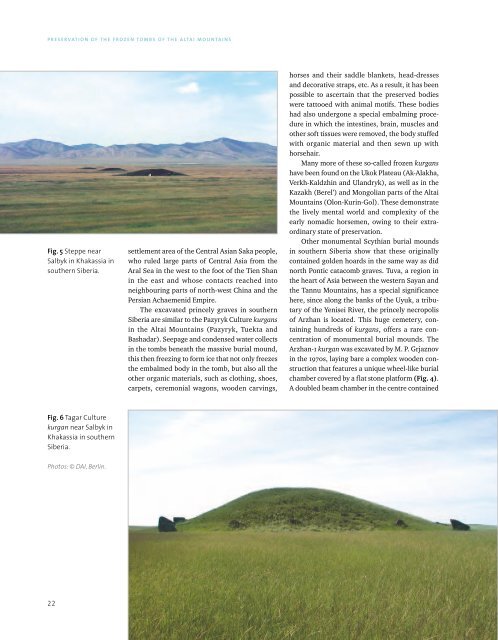Scythian Culture - Preservation of The Frozen Tombs of The Altai Mountains (UNESCO)
You also want an ePaper? Increase the reach of your titles
YUMPU automatically turns print PDFs into web optimized ePapers that Google loves.
PRESERVATION OF THE FROZEN TOMBS OF THE ALTAI MOUNTAINS<br />
Fig. 5 Steppe near<br />
Salbyk in Khakassia in<br />
southern Siberia.<br />
settlement area <strong>of</strong> the Central Asian Saka people,<br />
who ruled large parts <strong>of</strong> Central Asia from the<br />
Aral Sea in the west to the foot <strong>of</strong> the Tien Shan<br />
in the east and whose contacts reached into<br />
neighbouring parts <strong>of</strong> north-west China and the<br />
Persian Achaemenid Empire.<br />
<strong>The</strong> excavated princely graves in southern<br />
Siberia are similar to the Pazyryk <strong>Culture</strong> kurgans<br />
in the <strong>Altai</strong> <strong>Mountains</strong> (Pazyryk, Tuekta and<br />
Bashadar). Seepage and condensed water collects<br />
in the tombs beneath the massive burial mound,<br />
this then freezing to form ice that not only freezes<br />
the embalmed body in the tomb, but also all the<br />
other organic materials, such as clothing, shoes,<br />
carpets, ceremonial wagons, wooden carvings,<br />
horses and their saddle blankets, head-dresses<br />
and decorative straps, etc. As a result, it has been<br />
possible to ascertain that the preserved bodies<br />
were tattooed with animal motifs. <strong>The</strong>se bodies<br />
had also undergone a special embalming procedure<br />
in which the intestines, brain, muscles and<br />
other s<strong>of</strong>t tissues were removed, the body stuffed<br />
with organic material and then sewn up with<br />
horsehair.<br />
Many more <strong>of</strong> these so-called frozen kurgans<br />
have been found on the Ukok Plateau (Ak-Alakha,<br />
Verkh-Kaldzhin and Ulandryk), as well as in the<br />
Kazakh (Berel’) and Mongolian parts <strong>of</strong> the <strong>Altai</strong><br />
<strong>Mountains</strong> (Olon-Kurin-Gol). <strong>The</strong>se demonstrate<br />
the lively mental world and complexity <strong>of</strong> the<br />
early nomadic horsemen, owing to their extraordinary<br />
state <strong>of</strong> preservation.<br />
Other monumental <strong>Scythian</strong> burial mounds<br />
in southern Siberia show that these originally<br />
contained golden hoards in the same way as did<br />
north Pontic catacomb graves. Tuva, a region in<br />
the heart <strong>of</strong> Asia between the western Sayan and<br />
the Tannu <strong>Mountains</strong>, has a special significance<br />
here, since along the banks <strong>of</strong> the Uyuk, a tributary<br />
<strong>of</strong> the Yenisei River, the princely necropolis<br />
<strong>of</strong> Arzhan is located. This huge cemetery, containing<br />
hundreds <strong>of</strong> kurgans, <strong>of</strong>fers a rare concentration<br />
<strong>of</strong> monumental burial mounds. <strong>The</strong><br />
Arzhan-1 kurgan was excavated by M. P. Grjaznov<br />
in the 1970s, laying bare a complex wooden construction<br />
that features a unique wheel-like burial<br />
chamber covered by a flat stone platform (Fig. 4).<br />
A doubled beam chamber in the centre contained<br />
Fig. 6 Tagar <strong>Culture</strong><br />
kurgan near Salbyk in<br />
Khakassia in southern<br />
Siberia.<br />
Photos: © DAI, Berlin.<br />
22
















